TRENDNET TEW638PAP 300Mbps PoE Wireless N Access Point User Manual Manual Part 3
TRENDNET, Inc. 300Mbps PoE Wireless N Access Point Manual Part 3
TRENDNET >
Contents
- 1. Manual Part 1
- 2. Manual Part 2
- 3. Manual Part 3
Manual Part 3
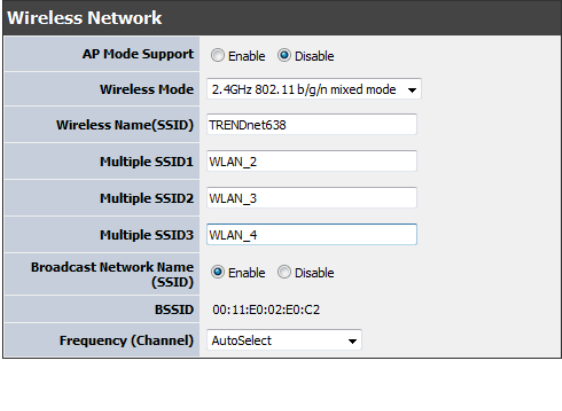
Add Additional Wireless Network Name (SSID)
To add additional Wireless Network Names simply add the name to the Multiple SSID field and click on
apply at the bottom of the page. When finished, go to the Security section in this Users Guide for wireless
security configuration.
Multiple SSIDs
Broadcast Network Name (SSID)
This option allows you to hide your wireless network. When this option is set to enable, your wireless
network name is broadcast to anyone within the range of your signal. If you're not using encryption then
they could connect to your network. When this mode is disabled, you must enter the Wireless Network
Name (SSID) on the client manually to connect to the network.
Frequency (Channel)
A wireless network uses specific channels in the wireless spectrum to handle communication between
clients. Some channels in your area may have interference from other electronic devices. Choose the
clearest channel to help optimize the performance and coverage of your wireless network.
Page 31
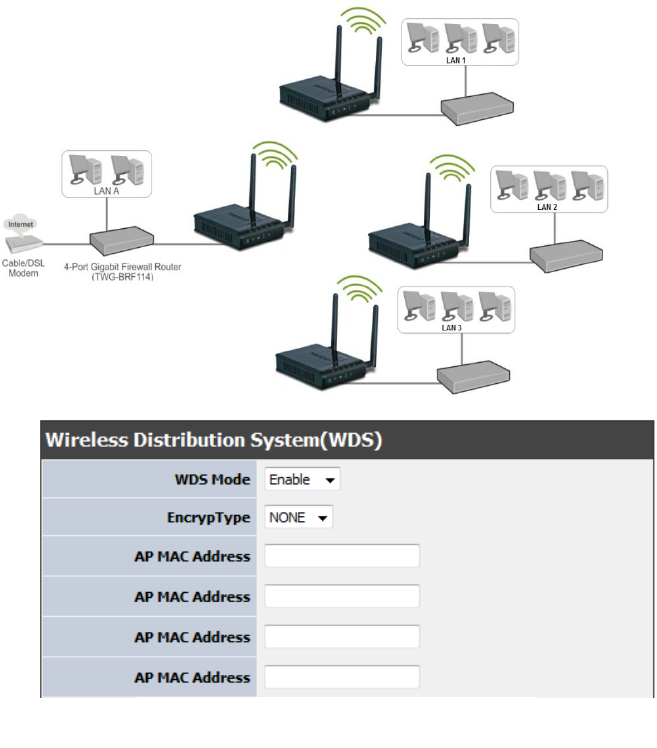
WDS Mode
When WDS is enabled, this access point functions as a wireless bridge and is able to wirelessly
communicate with other access points via WDS links. A WDS link is bidirectional; both end points must
support WDS and each access point must know the MAC Address of the other. Each access point will be
configured with the remote access point’s MAC address and vice versa. Make sure all access points are
configured with the same SSID, channel and wireless encryption settings.
WDS configuration option enabled
Operating Mode
If you have both wireless g and wireless n client devices included on your wireless network at the same
time, you should choose Mixed Mode. And if you only have wireless n client devices on your wireless
network, you can choose Green Field to enjoy high throughput.
Channel Bandwidth
The "20/40” MHz option is usually best. The other option is available for special circumstances.
Guard Interval
Page 32
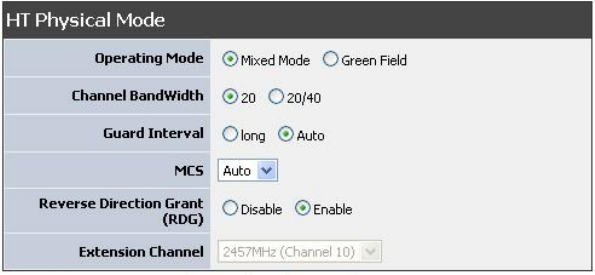
Using “Auto” option can increase throughput. However, it can also increase error rate in some
installations, due to increased sensitivity to radio-frequency reflections. Select the option that works best
for your installation.
MCS
The Modulation and Coding Scheme (MCS) is a value that determines the modulation, coding and
number of spatial channels. This parameter represents transmission rate. By default (Auto) the fastest
possible transmission rate will be selected. You have the option of selecting the speed if necessary.
Fix MCS rate for HT rate 0-15
Reserve Direction Grant (RDG)
Disable or enable reserve direction grant. Default is enabled.
Extension Channel
When 20/40 channel bandwidth has been chosen, you should select extension channel to get higher
throughput.
Page 33
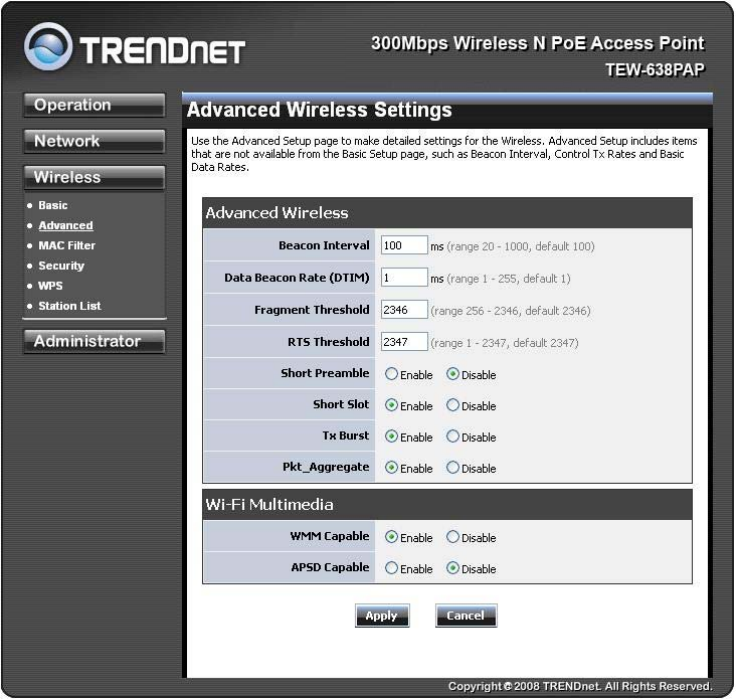
WirelessAdvanced
Beacon Interval
Beacons are packets sent by a wireless Access Point to synchronize wireless devices. Specify a Beacon
Period value between 20 and 1000. The default value is set to 100 milliseconds.
Data Beacon Rate (DTIM)
A DTIM is a countdown informing clients of the next window for listening to broadcast and multicast
messages. When the wireless Access Point has buffered broadcast or multicast messages for associated
clients, it sends the next DTIM with a DTIM Interval value. Wireless clients detect the beacons and
awaken to receive the broadcast and multicast messages. The default value is 1. Valid settings are
between 1 and 255.
Fragment Threshold
This setting should remain at its default value of 2346. Setting the Fragmentation value too low may
result in poor performance.
RTS Threshold
Page 34
This setting should remain at its default value of 2347. If you encounter inconsistent data flow, only
minor modifications to the value are recommended.
Short Preamble
Use to synchronize communication timing between devices on a network. Disable by default.
Short Slot
Enable or disable short slot. Default is enabled.
Tx Burst
Enable or disable Tx burst. Default is enabled.
Pkt_Aggregate
Enable or disable Pkt aggregate. Default is enabled.
Wi-Fi Multimedia
WMM Capable
Enabling WMM can help control latency and jitter when transmitting multimedia content over a wireless
connection.
APSD Capable
Enable or disable APSD (Adaptive power scheduling protocol) capable. Default is enabled.
*Maximum wireless signal rates are referenced from IEEE 802.11 theoretical specifications. Actual data throughput and
coverage will vary depending on interference, network traffic, building materials and other conditions
Page 35
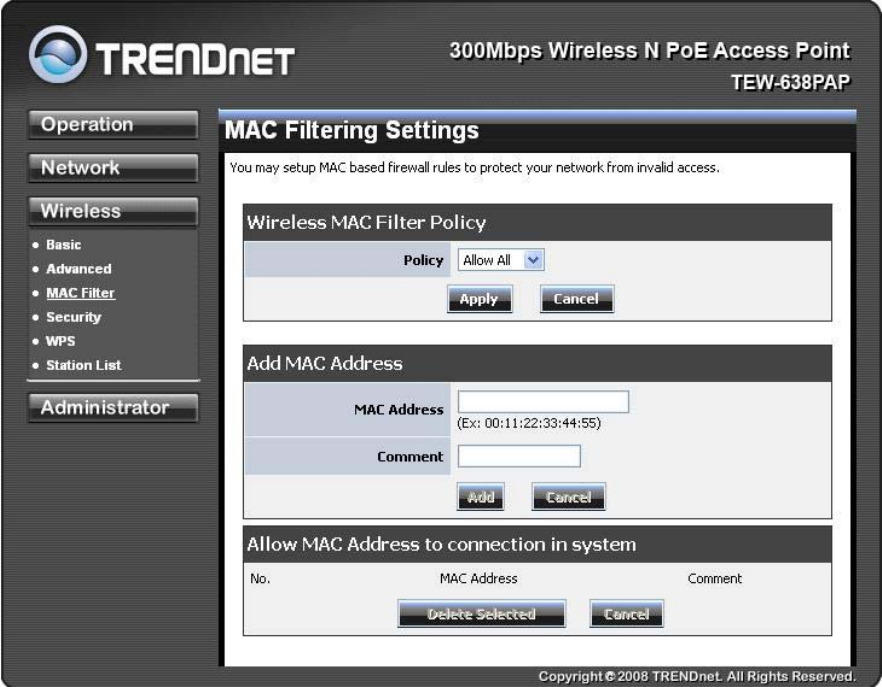
WirelessMACFilter
The MAC address filter section can be used to filter network access by machines based on the unique
MAC addresses of their network adapter(s). It is most useful to prevent unauthorized wireless devices
from connecting to your network. A MAC address is a unique ID assigned by the manufacturer of the
network adapter.
Policy
Three policies can be selected - Disable, Allow All & Reject All.
MAC Address
Add MAC Address to follow Policy setting
Page 36
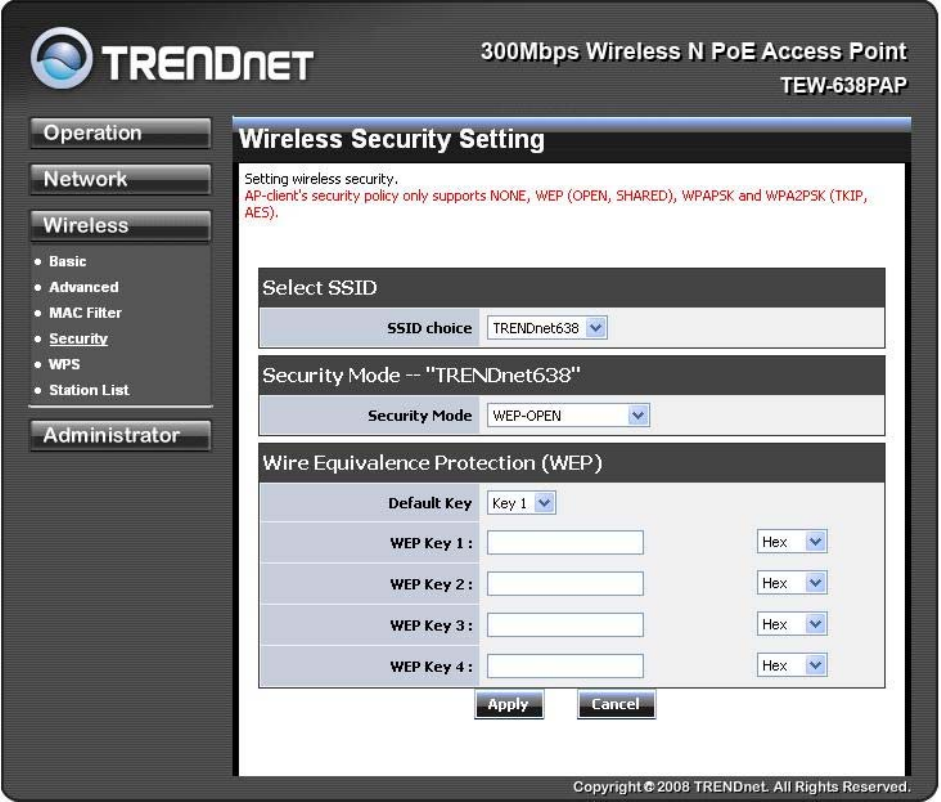
WirelessSecurity
SSID choice
Choose the SSID which need to implement security.
Security Mode
You can disable security mode, or you can choose following modes to enable security – Disable,
WEP-OPEN,WEP-SHARED ,WEP-AUTO, WPA, WPA-PSK, WPA2, WPA2-PSK,
WPA-PSK/WPA2-PSK,WPA/WPA2
Page 37
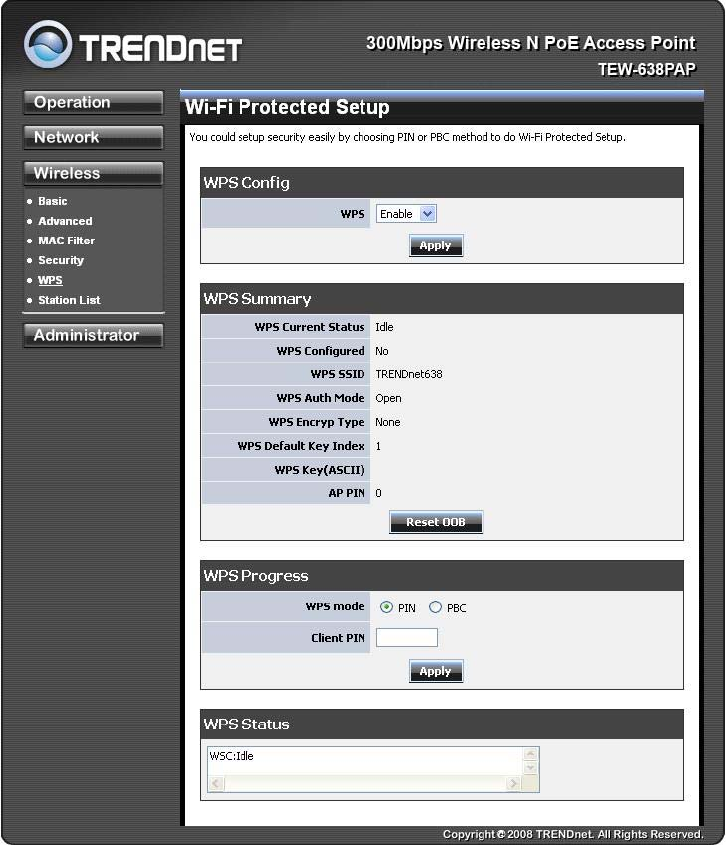
WirelessWPS
You can setup security easily by choosing PIN or PBC method to do Wi-Fi Protected Setup.
WPS mode
Two WPS modes can be selected – PIN & PBC. If PIN is selected, you should enter PIN code of your
wireless client device to get wireless connection with this AP.
Page 38
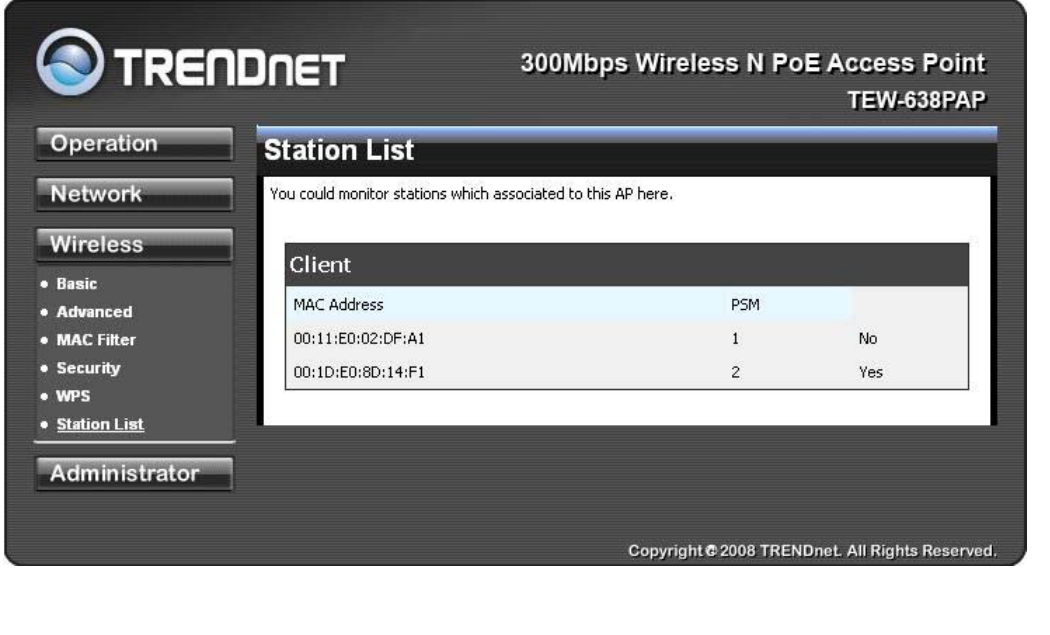
WirelessStationList
You can monitor stations which associated to this AP.
Page 39
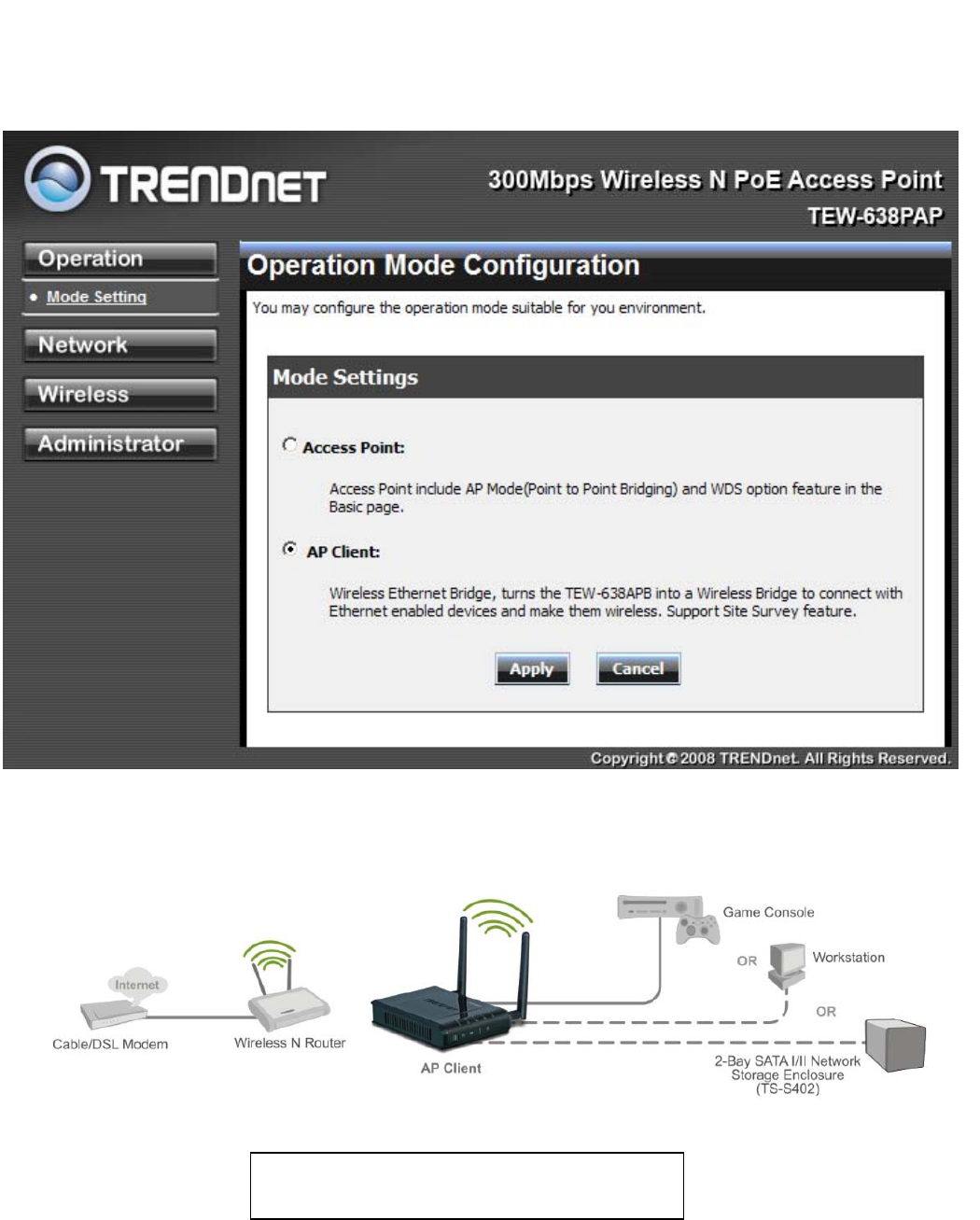
WIRELESSBASIC–APCLIENT
Select the AP Client option to use the TEW-638PAP as a wireless network adapter. Use this
feature to connect other Ethernet devices and allow them to become wirelessly enabled. Select
the option AP Client and apply the setting at the bottom of the window.
AP Client allows Ethernet enabled devices
to become wirelessly enabled.
Page 40
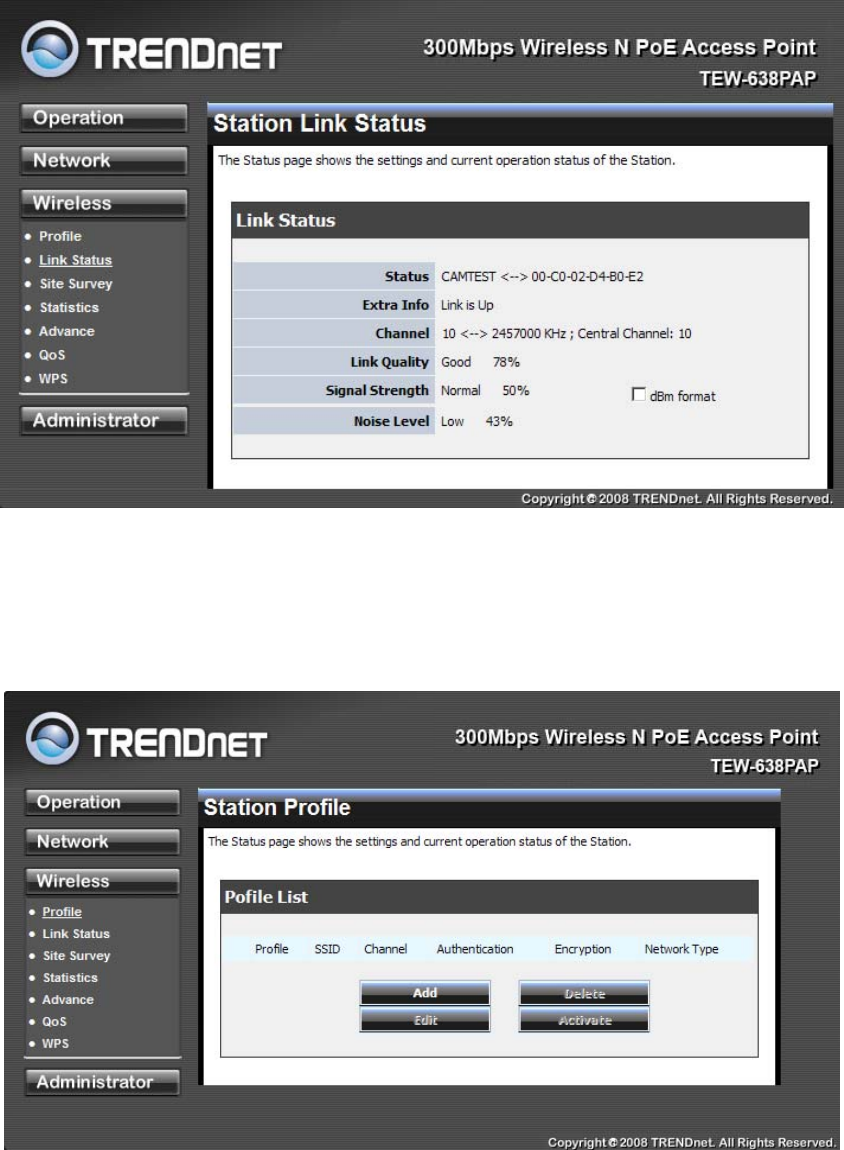
Wirelesssettings
View the current Link Status of the TEW-638PAP in AP Client mode.
Profile
Create a custom connection to a specific wireless network. Use this option to make custom
profiles and store new profile for later use.
Configure the setting to connect to a wireless network, selection option for network type, SSID,
and wireless security. The profile can be edited, deleted and made active from this option.
Page 41
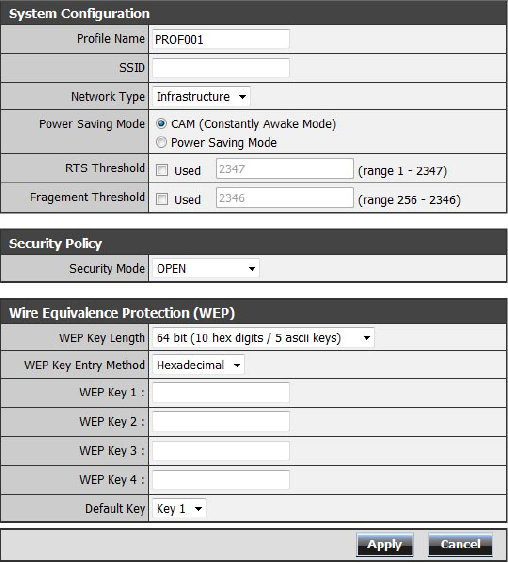
SiteSurvey
Use the Site Survey tool to search for wireless networks in the TEW-638PAP area. Click on the
Scan button to search for wireless networks to join. From this window, you can also add your
profile to use with the TEW-638PAP. Click on the Connect button to join a wireless network
from this site survey window.
Page 42
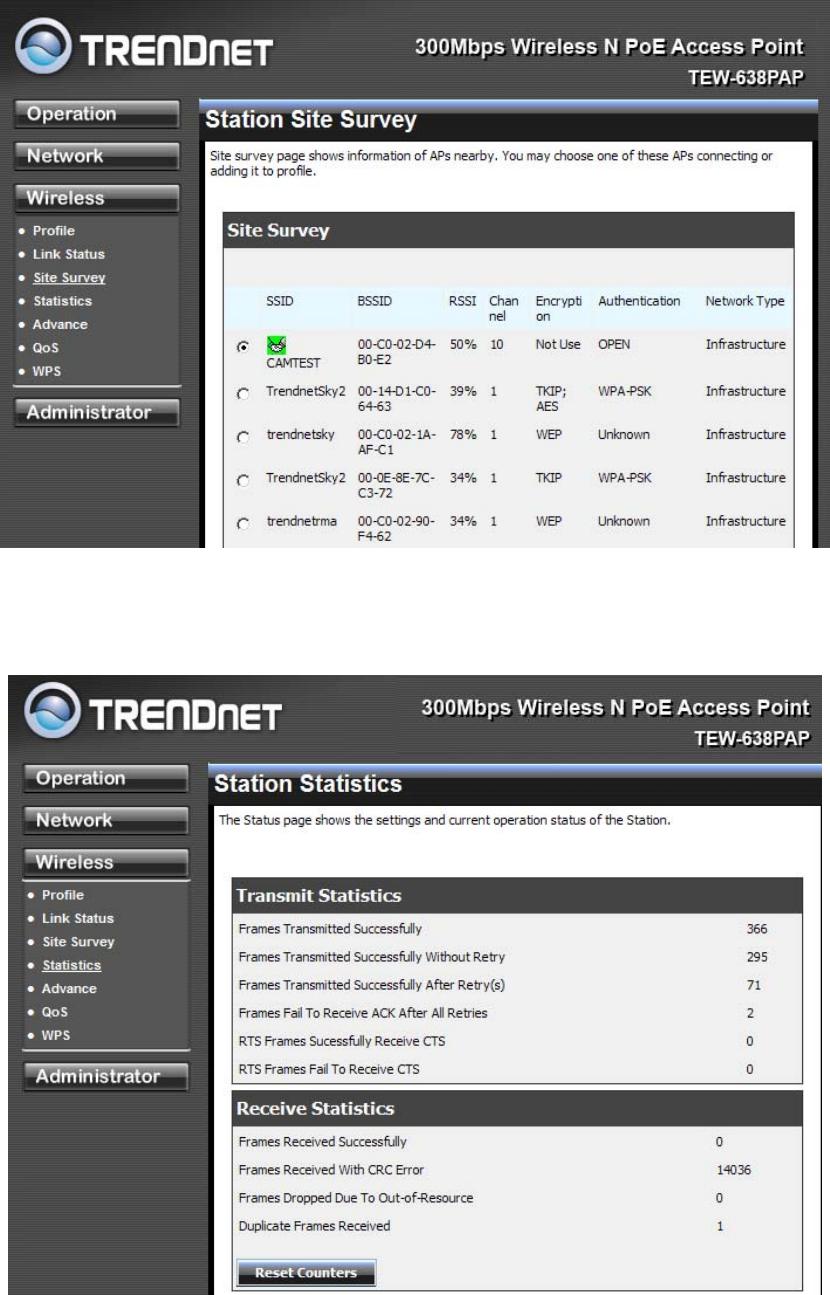
Statistics
View the current operating status of the TEW-638PAP, see the Transmit and Receive data.
Page 43
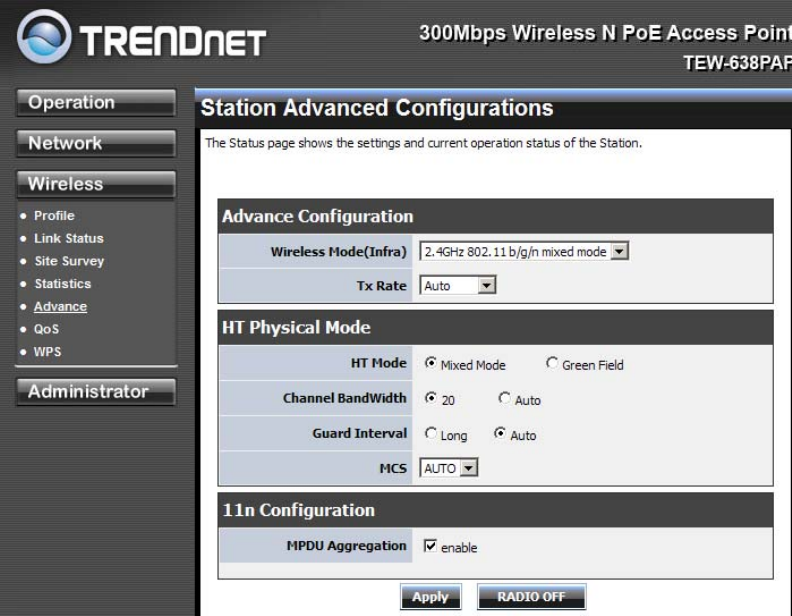
AdvanceSetting
Use this setting to adjust the wireless environment.
In Advance Configuration, select the Wireless Mode for the TEW-638PAPto match the speed
of the Access Point or wireless Router that will be connecting with. Select the following from the
drop down list.
802.11b/g mixed mode (2.4GHz) - This wireless mode works in the 2.4GHz frequency range and
will allow both wireless b and wireless g client to connect and access the TEW-638PAP at
11Mbps for wireless b, at 54Mbps for wireless g and share access at the same time. Although the
wireless b/g operates in the 2.4GHz frequency, it will allow the use of other 2.4GHz client devices
(Wireless n/g @ 54Mbps) to connect and access at the same time.
802.11n only (2.4GHz) - This wireless mode works in the 2.4GHz frequency range and will only
allow the use of wireless n client devices to connect and access the TEW-638PAP up to
300Mbps*. Although the wireless n operates in the 2.4GHz frequency, this mode will only permit
wireless n client devices to work and will exclude any other wireless mode and devices that are
not wireless n only.
802.11b/g/n mixed mode (2.4GHz) - This wireless mode works in the 2.4GHz frequency range
and will only allow the use of wireless g client devices to connect and access the TEW-638PAP at
11Mbps for wireless b, 54Mbps for wireless g and up to 300Mbps* for wireless n and share
access at the same time. Although the wireless b/g/n operates in the same 2.4GHz frequency, it
will allow the use of other 2.4GHz client devices (Wireless b/g/n) to connect and access at the
same time.
TX Rate option is only available with 802.11 b/g mixed and 802.11 b/g/n modes, wireless n does
not use this setting. Select the throughput transmission from the drop down list
Page 44
(1Mbps~54Mbps).
HT Physical Mode is used to configure the wireless n settings.
Mixed Mode If you have both wireless g and wireless n client devices included on your wireless
network at the same time, you should choose.
Green Field if you only have wireless n client devices on your wireless network, you can
choose to enjoy high throughput.
Channel Bandwidth
The "20/40” MHz option is usually best. The other option is available for special circumstances.
Guard Interval
Using “Auto” option can increase throughput. However, it can also increase error rate in some
installations, due to increased sensitivity to radio-frequency reflections. Select the option that
works best for your installation.
MCS
The Modulation and Coding Scheme (MCS) is a value that determines the modulation, coding
and number of spatial channels. This parameter represents transmission rate. By default (Auto)
the fastest possible transmission rate will be selected. You have the option of selecting the speed
if necessary.
11n Configuration is an aggregation process of packing multiple together to reduce the
overheads and average them over multiple frames, thus increasing the data rate.
Page 45
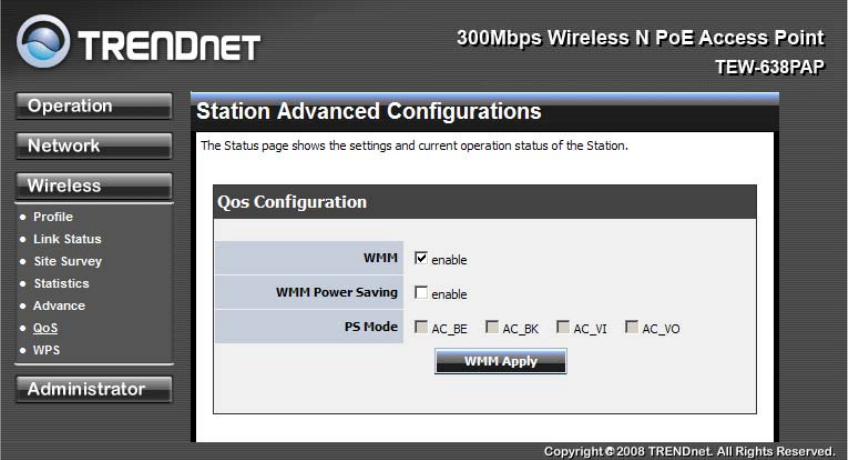
QoS
Use this setting to give the TEW-638PAP priority over other wireless networking devices.
WMM (Wireless Multi-Media) use this feature allows wireless devices to take advantage of the
wireless environment over other wireless devices.
WMM Power Saving is an option that allows wireless clients such as notebooks or Laptops to
save battery life by sending less transmission during idle times. Add a check mark to enable this
option.
PS Mode is used for specific application when using WMM Power Saving mode is enabled, use
this feature to help with Quality of Service (QoS) settings; these settings are polled by the
priority given to the option in this section.
AC_BE=Best Effort
AC_BK=Background
AC_VI=Video
AC_VO=Voice
Page 46
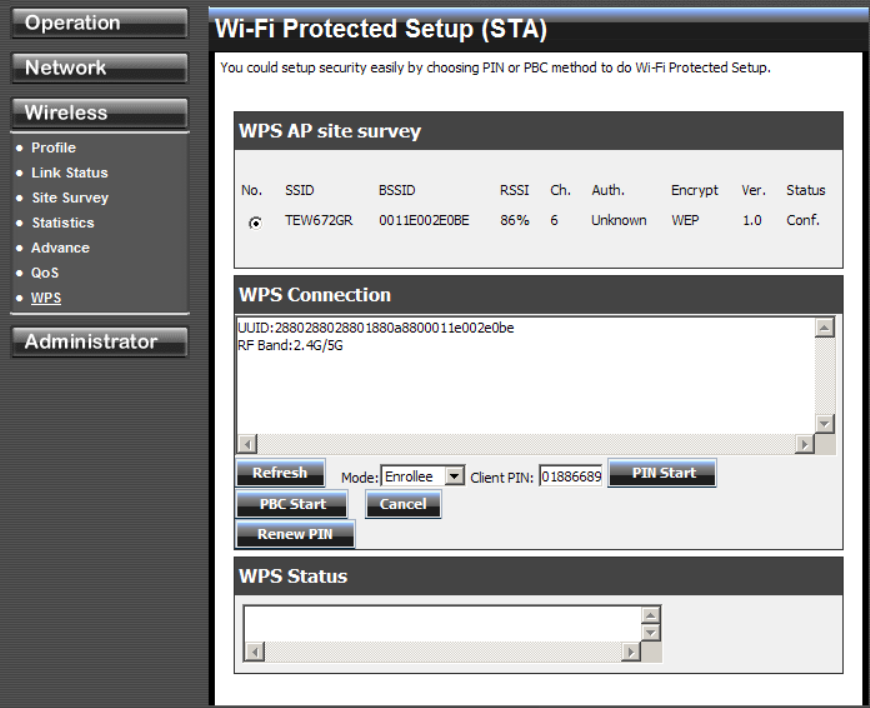
WPS
ou can setup security easily by choosing PIN or PBC method to do Wi-Fi Protected Setup.
Y
wo WPS modes can be selected – PIN & PBC. If PIN is selected, you should enter PIN code of your T
wireless client device to get wireless connection with this AP.
Page 47
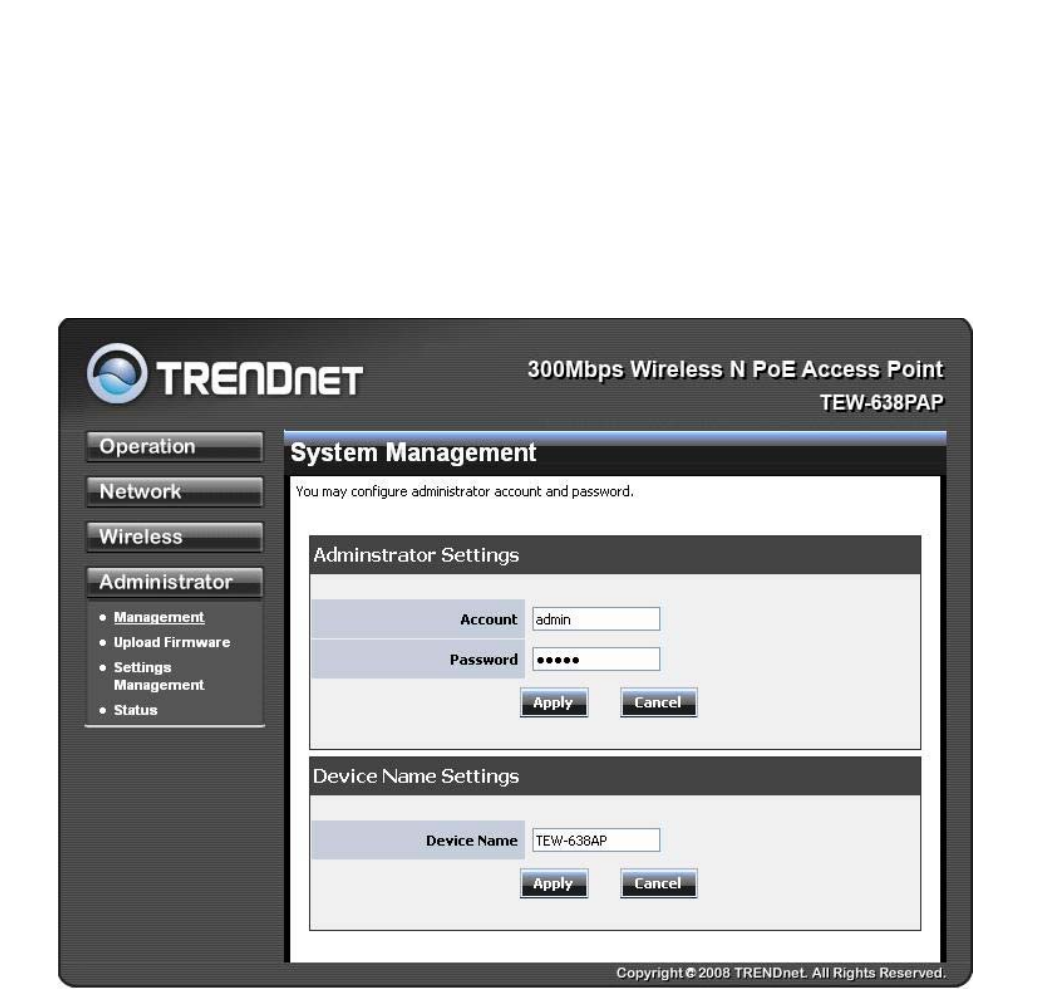
ADMINISTRATOR
o set password for access to the Web-based management, also
figuration options: Management, Upload Firmware,
ystemManagement
igure administrator account and password.
This Administrator section is used t
provide function of firmware upgrade.
The Administrator tab provides the following con
settings, Management and Status.
S
At this page, you can conf
Page 48
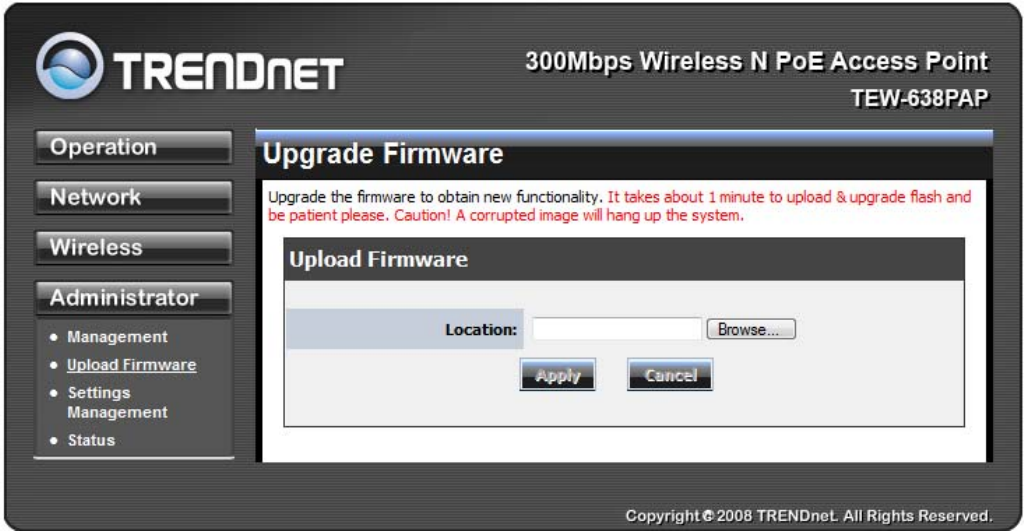
UploadFirmware
By assigning firmware location, you can upload firmware at this page.
Page 49
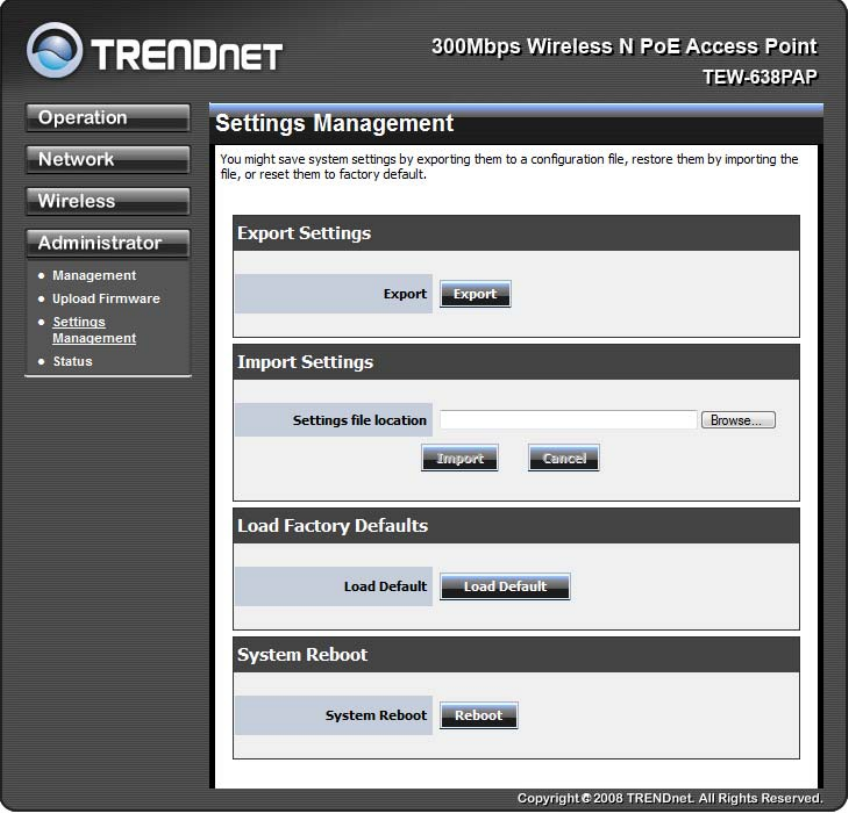
SettingsManagement
You can save system settings by exporting them to a configuration file, restore them by
importing the file, or reset them to factory default.
Page 50
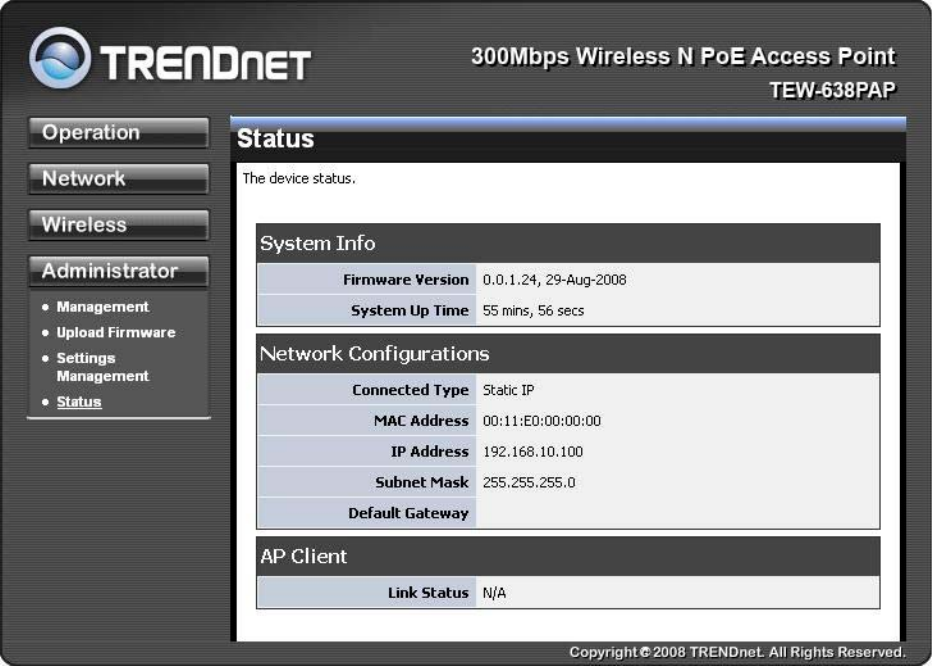
Status
You can check system information and network configurations on this page.
Page 51
Glossary
A
Access Control List
ACL. This is a database of network devices that are allowed to access resources on the network.
Access Point
AP. Device that allows wireless clients to connect to it and access the network
Ad-hoc network
Peer-to-Peer network between wireless clients
Address Resolution Protocol
ARP. Used to map MAC addresses to IP addresses so that conversions can be made in both directions.
Advanced Encryption Standard
AES. Government encryption standard
Alphanumeric
Characters A-Z and 0-9
Antenna
Used to transmit and receive RF signals.
ASCII
American Standard Code for Information Interchange. This system of characters is most commonly used
for text files
Attenuation
The loss in strength of digital and analog signals. The loss is greater when the signal is being transmitted
over long distances.
Authentication
To provide credentials, like a Password, in order to verify that the person or device is really who they are
claiming to be
Automatic Private IP Addressing
APIPA. An IP address that that a Windows computer will assign itself when it is configured to obtain an
IP address automatically but no DHCP server is available on the network
B
Backward Compatible
The ability for new devices to communicate and interact with older legacy devices to guarantee
interoperability
Bandwidth
The maximum amount of bytes or bits per second that can be transmitted to and from a network device
Beacon
A data frame by which one of the stations in a Wi-Fi network periodically broadcasts network control data
to other wireless stations.
Bit rate
The amount of bits that pass in given amount of time
Bit/sec
Bits per second
BOOTP
Bootstrap Protocol. Allows for computers to be booted up and given an IP address with no user
intervention
Broadcast
Transmitting data in all directions at once
Browser
Page 52
A program that allows you to access resources on the web and provides them to you graphically
C
CAT 5
Category 5. Used for 10/100 Mbps or 1Gbps Ethernet connections
Client
A program or user that requests data from a server
Collision
When do two devices on the same Ethernet network try and transmit data at the exact same time.
Cookie
Information that is stored on the hard drive of your computer that holds your preferences to the site that
gave your computer the cookie
D
Data
Information that has been translated into binary so that it can be processed or moved to another device
Data-Link layer
The second layer of the OSI model. Controls the movement of data on the physical link of a network
dBd
Decibels related to dipole antenna
dBi
Decibels relative to isotropic radiator
dBm
Decibels relative to one milliwatt
Decrypt
To unscramble an encrypted message back into plain text
Default
A predetermined value or setting that is used by a program when no user input has been entered for this
value or setting
DHCP
Dynamic Host Configuration Protocol: Used to automatically assign IP addresses from a predefined pool
of addresses to computers or devices that request them
Digital certificate:
An electronic method of providing credentials to a server in order to have access to it or a network
Direct Sequence Spread Spectrum
DSSS: Modulation technique used by 802.11b wireless devices
DNS
Domain Name System: Translates Domain Names to IP addresses
Domain name
A name that is associated with an IP address
Download
To send a request from one computer to another and have the file transmitted back to the requesting
computer
Duplex
Sending and Receiving data transmissions at the sane time
Dynamic IP address
IP address that is assigned by a DHCP server and that may change. Cable Internet providers usually use
this method to assign IP addresses to their customers.
Page 53
E
EAP
Extensible Authentication Protocol
Encryption
Converting data into cyphertext so that it cannot be easily read
Ethernet
The most widely used technology for Local Area Networks.
F
File server
A computer on a network that stores data so that the other computers on the network can all access it
File sharing
Allowing data from computers on a network to be accessed by other computers on the network with
different levels of access rights
Firewall
A device that protects resources of the Local Area Network from unauthorized users outside of the local
network
Firmware
Programming that is inserted into a hardware device that tells it how to function
Fragmentation
Breaking up data into smaller pieces to make it easier to store
FTP
File Transfer Protocol. Easiest way to transfer files between computers on the Internet
Full-duplex
Sending and Receiving data at the same time
G
Gain
The amount an amplifier boosts the wireless signal
Gateway
A device that connects your network to another, like the internet
Gbps
Gigabits per second
Gigabit Ethernet
Transmission technology that provides a data rate of 1 billion bits per second
GUI
Graphical user interface
H
Half-duplex
Data cannot be transmitted and received at the same time
Hashing
Transforming a string of characters into a shorter string with a predefined length
Hexadecimal
Characters 0-9 and A-F
Hop
The action of data packets being transmitted from one AP to another
Page 54
Host
Computer on a network
HTTP
Hypertext Transfer Protocol is used to transfer files from HTTP servers (web servers) to HTTP clients
(web browsers)
HTTPS
HTTP over SSL is used to encrypt and decrypt HTTP transmissions
Hub
A networking device that connects multiple devices together
I
ICMP
Internet Control Message Protocol
IEEE
Institute of Electrical and Electronics Engineers
IGMP
Internet Group Management Protocol is used to make sure that computers can report their multicast group
membership to adjacent APs
IIS
Internet Information Server is a WEB server and FTP server provided by Microsoft
Infrastructure
In terms of a wireless network, this is when wireless clients use an Access Point to gain access to the
network
Internet
A system of worldwide networks which use TCP/IP to allow for resources to be accessed from computers
around the world
Internet Explorer
A World Wide Web browser created and provided by Microsoft
Internet Protocol
The method of transferring data from one computer to another on the Internet
Internet Protocol Security
IPsec provides security at the packet processing layer of network communication
Internet Service Provider
An ISP provides access to the Internet to individuals or companies
Intranet
A private network
Intrusion Detection
A type of security that scans a network to detect attacks coming from inside and outside of the network
IP
Internet Protocol
IP address
A 32-bit number, when talking about Internet Protocol Version 4, that identifies each computer that
transmits data on the Internet or on an Intranet
IPsec
Internet Protocol Security
IPX
Internetwork Packet Exchange is a networking protocol developed by Novel to enable their Netware
clients and servers to communicate
ISP
Page 55
Internet Service Provider
J
Java
A programming language used to create programs and applets for web pages
K
Kbps
Kilobits per second
Kbyte
Kilobyte
L
LAN
Local Area Network
Latency
The amount of time that it takes a packet to get from the one point to another on a network. Also referred
to as delay
LED
Light Emitting Diode
Legacy
Older devices or technology
Local Area Network
A group of computers in a building that usually access files from a server
LPR/LPD
"Line Printer Requestor"/"Line Printer Daemon". A TCP/IP protocol for transmitting streams of printer
data.
L2TP
Layer 2 Tunneling Protocol
M
MAC address
A unique hardware ID assigned to every Ethernet adapter by the manufacturer.
Mbps
Megabits per second
MDI
Medium Dependent Interface is an Ethernet port for a connection to a straight-through cable
MDIX
Medium Dependent Interface Crossover, is an Ethernet port for a connection to a crossover cable
MIB
Management Information Base is a set of objects that can be managed by using SNMP
Modem
A device that Modulates digital signals from a computer to an analog signal in order to transmit the signal
over phone lines. It also Demodulates the analog signals coming from the phone lines to digital signals for
your computer
MPPE
Microsoft Point-to-Point Encryption is used to secure data transmissions over PPTP connections
Page 56
MTU
Maximum Transmission Unit is the largest packet that can be transmitted on a packet-based network like
the Internet
Multicast
Sending data from one device to many devices on a network
N
NAT
Network Address Translation allows many private IP addresses to connect to the Internet, or another
network, through one IP address
NetBEUI
NetBIOS Extended User Interface is a Local Area Network communication protocol. This is an updated
version of NetBIOS
NetBIOS
Network Basic Input/Output System
Netmask
Determines what portion of an IP address designates the Network and which part designates the Host
Network Interface Card
A card installed in a computer or built onto the motherboard that allows the computer to connect to a
network
Network Layer
The third layer of the OSI model which handles the routing of traffic on a network
Network Time Protocol
Used to synchronize the time of all the computers in a network
NIC
Network Interface Card
NTP
Network Time Protocol
O
OFDM
Orthogonal Frequency-Division Multiplexing is the modulation technique for both 802.11a and
802.wireless g
OSI
Open Systems Interconnection is the reference model for how data should travel between two devices on a
network
OSPF
Open Shortest Path First is a routing protocol that is used more than RIP in larger scale networks because
only changes to the routing table are sent to all the other APs in the network as opposed to sending the
entire routing table at a regular interval, which is how RIP functions
P
Password
A sequence of characters that is used to authenticate requests to resources on a network
Personal Area Network
The interconnection of networking devices within a range of 10 meters
Physical layer
The first layer of the OSI model. Provides the hardware means of transmitting electrical signals on a data
Page 57
carrier
Ping
A utility program that verifies that a given Internet address exists and can receive messages. The utility
sends a control packet to the given address and waits for a response.
PoE
Power over Ethernet is the means of transmitting electricity over the unused pairs in a category 5 Ethernet
cable
Port
A logical channel endpoint in a network. A computer might have only one physical channel (its Ethernet
channel) but can have multiple ports (logical channels) each identified by a number.
PPP
Point-to-Point Protocol is used for two computers to communicate with each over a serial interface, like a
phone line
PPPoE
Point-to-Point Protocol over Ethernet is used to connect multiple computers to a remote server over
Ethernet
PPTP
Point-to-Point Tunneling Protocol is used for creating VPN tunnels over the Internet between two
networks
Preamble
Used to synchronize communication timing between devices on a network
Q
QoS
Quality of Service
R
RADIUS
Remote Authentication Dial-In User Service allows for remote users to dial into a central server and be
authenticated in order to access resources on a network
Reboot
To restart a computer and reload it's operating software or firmware from nonvolatile storage.
Rendezvous
Apple's version of UPnP, which allows for devices on a network to discover each other and be connected
without the need to configure any settings
Repeater
Retransmits the signal of an Access Point in order to extend it's coverage
RIP
Routing Information Protocol is used to synchronize the routing table of all the APs on a network
RJ-11
The most commonly used connection method for telephones
RJ-45
The most commonly used connection method for Ethernet
RS-232C
The interface for serial communication between computers and other related devices
RSA
Algorithm used for encryption and authentication
Page 58
S
Server
A computer on a network that provides services and resources to other computers on the network
Session key
An encryption and decryption key that is generated for every communication session between two
computers
Session layer
The fifth layer of the OSI model which coordinates the connection and communication between
applications on both ends
Simple Mail Transfer Protocol
Used for sending and receiving email
Simple Network Management Protocol
Governs the management and monitoring of network devices
SIP
Session Initiation Protocol. A standard protocol for initiating a user session that involves multimedia
content, such as voice or chat.
SMTP
Simple Mail Transfer Protocol
SNMP
Simple Network Management Protocol
SOHO
Small Office/Home Office
SPI
Stateful Packet Inspection
SSH
Secure Shell is a command line interface that allows for secure connections to remote computers
SSID
Service Set Identifier is a name for a wireless network
Stateful inspection
A feature of a firewall that monitors outgoing and incoming traffic to make sure that only valid responses
to outgoing requests are allowed to pass though the firewall
Subnet mask
Determines what portion of an IP address designates the Network and which part designates the Host
Syslog
System Logger -- a distributed logging interface for collecting in one place the logs from different sources.
Originally written for UNIX, it is now available for other operating systems, including Windows.
T
TCP
Transmission Control Protocol
TCP/IP
Transmission Control Protocol/Internet Protocol
TCP Raw
A TCP/IP protocol for transmitting streams of printer data.
TFTP
Trivial File Transfer Protocol is a utility used for transferring files that is simpler to use than FTP but with
less features
Throughput
The amount of data that can be transferred in a given time period
Page 59
Traceroute
A utility displays the routes between you computer and specific destination
U
UDP
User Datagram Protocol
Unicast
Communication between a single sender and receiver
Universal Plug and Play
A standard that allows network devices to discover each other and configure themselves to be a part of the
network
Upgrade
To install a more recent version of a software or firmware product
Upload
To send a request from one computer to another and have a file transmitted from the requesting computer
to the other
UPnP
Universal Plug and Play
URL
Uniform Resource Locator is a unique address for files accessible on the Internet
USB
Universal Serial Bus
UTP
Unshielded Twisted Pair
V
Virtual Private Network
VPN: A secure tunnel over the Internet to connect remote offices or users to their company's network
VLAN
Virtual LAN
Voice over IP
Sending voice information over the Internet as opposed to the PSTN
VoIP
Voice over IP
W
Wake on LAN
Allows you to power up a computer though it's Network Interface Card
WAN
Wide Area Network
WCN
Windows Connect Now. A Microsoft method for configuring and bootstrapping wireless networking
hardware (access points) and wireless clients, including PCs and other devices.
WDS
Wireless Distribution System. A system that enables the interconnection of access points wirelessly.
Web browser
A utility that allows you to view content and interact with all of the information on the World Wide Web
WEP
Wired Equivalent Privacy is security for wireless networks that is supposed to be comparable to that of a
Page 60
wired network
Wi-Fi
Wireless Fidelity
Wi-Fi Protected Access
An updated version of security for wireless networks that provides authentication as well as encryption
Wide Area Network
The larger network that your LAN is connected to, which may be the Internet itself, or a regional or
corporate network
Wireless ISP
A company that provides a broadband Internet connection over a wireless connection
Wireless LAN
Connecting to a Local Area Network over one of the 802.11 wireless standards
WISP
Wireless Internet Service Provider
WLAN
Wireless Local Area Network
WPA
Wi-Fi Protected Access. A Wi-Fi security enhancement that provides improved data encryption, relative
to WEP.
X
xDSL
A generic term for the family of digital subscriber line (DSL) technologies, such as ADSL, HDSL,
RADSL, and SDSL.
Y
Yagi antenna
A directional antenna used to concentrate wireless signals on a specific location
802.11
A family of specifications for wireless local area networks (WLANs) developed by a working group of
the Institute of Electrical and Electronics Engineers (IEEE).
Page 61

Specifications
Hardware
Standards IEEE 802.11n, 802.11b, 802.11g, , 802.11e and 802.3af
Interface 1 x 10/100Mbps Auto-MDIX PoE LAN port
LED Indicators Power, LAN, WPS, and Wireless
Buttons
Reset button – restores factory default settings
WPS button - initiates WPS function
On/off power switch
Power Supply 12V DC 0.5A external power adapter
Power Consumption 3.12 watts
Dimensions
(LxWxH) 120 x 26 x 88mm (4.7 x 1.0 x 3.4in.)
Weight 145g (5.11oz)
Temperature Operating: 0° ~ 40°C (32° ~ 104°F), Storage: -20°C ~ 60°C (-4° ~ 140°F)
Humidity Operating: 5% ~ 90% non-condensing, Storage: 5% ~ 90% non-condensing
Certifications CE, FCC
Wireless
Modulation Technique OFDM: BPSK, QPSK, 16-QAM, 64-QAM
DBPSK, DQPSK, CCK
Modes Access Point, Wireless Distribution System (WDS in AP mode), AP Client
Antenna 2 x 2dBi detachable antennas
Frequency 2.412 - 2.472 GHz
Data Rate (Auto Fallback) 802.11n: up to 300Mbps
802.11g: up to 54Mbps
802.11b: up to 11Mbps
Output Power 802.11n: 12dBm (typical)
802.11g: 15dBm (typical)
802.11b: 18dBm (typical)
Receiving Sensitivity 802.11n: -66dBm (typical)
802.11g: -74dBm (typical)
802.11b: -84dBm (typical)
Encryption 64/128-bit WEP, WPA/WPA2-RADIUS, WPA/WPA2-PSK
Channels 1-11 (FCC), 1-13 (ETSI)
*Maximum wireless signal rates are referenced from IEEE 802.11 theoretical specifications. Actual data throughput and
coverage will vary depending on interference, network traffic, building materials and other conditions.
Page 62
LimitedWarranty
TRENDnetwarrantsitsproductsagainstdefectsinmaterialandworkmanship,undernormaluseand
service,forthefollowinglengthsoftimefromthedateofpurchase.
TEW‐638PAP–3YearsWarranty
AC/DCPowerAdapter,CoolingFan,andPowerSupplycarry1yearwarranty.
Ifaproductdoesnotoperateaswarrantedduringtheapplicablewarrantyperiod,TRENDnetshall
reservetheright,atitsexpense,torepairorreplacethedefectiveproductorpartanddeliveran
equivalentproductorparttothecustomer.Therepair/replacementunit’swarrantycontinuesfromthe
originaldateofpurchase.AllproductsthatarereplacedbecomethepropertyofTRENDnet.Replacement
productsmaybeneworreconditioned.TRENDnetdoesnotissuerefundsorcredit.Pleasecontactthe
point‐of‐purchasefortheirreturnpolicies.
TRENDnetshallnotberesponsibleforanysoftware,firmware,information,ormemorydataofcustomer
containedin,storedon,orintegratedwithanyproductsreturnedtoTRENDnetpursuanttoanywarranty.
Therearenouserserviceablepartsinsidetheproduct.Donotremoveorattempttoservicethe
productbyanyunauthorizedservicecenter.Thiswarrantyisvoidedif(i)theproducthasbeenmodified
orrepairedbyanyunauthorizedservicecenter,(ii)theproductwassubjecttoaccident,abuse,or
improperuse(iii)theproductwassubjecttoconditionsmoreseverethanthosespecifiedinthemanual.
WarrantyservicemaybeobtainedbycontactingTRENDnetwithintheapplicablewarrantyperiodand
providingacopyofthedatedproofofthepurchase.Uponpropersubmissionofrequireddocumentation
aReturnMaterialAuthorization(RMA)numberwillbeissued.AnRMAnumberisrequiredinorderto
initiatewarrantyservicesupportforallTRENDnetproducts.ProductsthataresenttoTRENDnetforRMA
servicemusthavetheRMAnumbermarkedontheoutsideofreturnpackagesandsenttoTRENDnet
prepaid,insuredandpackagedappropriatelyforsafeshipment.Customersshippingfromoutsideofthe
USAandCanadaareresponsibleforreturnshippingfees.CustomersshippingfromoutsideoftheUSA
areresponsibleforcustomcharges,includingbutnotlimitedto,duty,tax,andotherfees.
WARRANTIESEXCLUSIVE:IFTHETRENDNETPRODUCTDOESNOTOPERATEASWARRANTEDABOVE,THE
CUSTOMER’SSOLEREMEDYSHALLBE,ATTRENDNET’SOPTION,REPAIRORREPLACE.THEFOREGOING
WARRANTIESANDREMEDIESAREEXCLUSIVEANDAREINLIEUOFALLOTHERWARRANTIES,EXPRESSED
ORIMPLIED,EITHERINFACTORBYOPERATIONOFLAW,STATUTORYOROTHERWISE,INCLUDING
WARRANTIESOFMERCHANTABILITYANDFITNESSFORAPARTICULARPURPOSE.TRENDNETNEITHER
ASSUMESNORAUTHORIZESANYOTHERPERSONTOASSUMEFORITANYOTHERLIABILITYIN
CONNECTIONWITHTHESALE,INSTALLATIONMAINTENANCEORUSEOFTRENDNET’SPRODUCTS.
TRENDNETSHALLNOTBELIABLEUNDERTHISWARRANTYIFITSTESTINGANDEXAMINATIONDISCLOSE
THATTHEALLEGEDDEFECTINTHEPRODUCTDOESNOTEXISTORWASCAUSEDBYCUSTOMER’SORANY
THIRDPERSON’SMISUSE,NEGLECT,IMPROPERINSTALLATIONORTESTING,UNAUTHORIZEDATTEMPTS
TOREPAIRORMODIFY,ORANYOTHERCAUSEBEYONDTHERANGEOFTHEINTENDEDUSE,ORBY
ACCIDENT,FIRE,LIGHTNING,OROTHERHAZARD.
Page 63

LIMITATIONOFLIABILITY:TOTHEFULLEXTENTALLOWEDBYLAWTRENDNETALSOEXCLUDESFORITSELF
ANDITSSUPPLIERSANYLIABILITY,WHETHERBASEDINCONTRACTORTORT(INCLUDINGNEGLIGENCE),
FORINCIDENTAL,CONSEQUENTIAL,INDIRECT,SPECIAL,ORPUNITIVEDAMAGESOFANYKIND,ORFOR
LOSSOFREVENUEORPROFITS,LOSSOFBUSINESS,LOSSOFINFORMATIONORDATE,OROTHER
FINANCIALLOSSARISINGOUTOFORINCONNECTIONWITHTHESALE,INSTALLATION,MAINTENANCE,
USE,PERFORMANCE,FAILURE,ORINTERRUPTIONOFTHEPOSSIBILITYOFSUCHDAMAGES,ANDLIMITS
ITSLIABILITYTOREPAIR,REPLACEMENT,ORREFUNDOFTHEPURCHASEPRICEPAID,ATTRENDNET’S
OPTION.THISDISCLAIMEROFLIABILITYFORDAMAGESWILLNOTBEAFFECTEDIFANYREMEDY
PROVIDEDHEREINSHALLFAILOFITSESSENTIALPURPOSE.
GoverningLaw:ThisLimitedWarrantyshallbegovernedbythelawsofthestateofCalifornia.
SomeTRENDnetproductsincludesoftwarecodewrittenbythirdpartydevelopers.Thesecodesare
subjecttotheGNUGeneralPublicLicense("GPL")orGNULesserGeneralPublicLicense("LGPL").
Gotohttp://www.trendnet.com/gplorhttp://www.trendnet.comDownloadsectionandlookforthe
desiredTRENDnetproducttoaccesstotheGPLCodeorLGPLCode.Thesecodesaredistributed
WITHOUTWARRANTYandaresubjecttothecopyrightsofthedevelopers.TRENDnetdoesnotprovide
technicalsupportforthesecodes.Pleasegotohttp://www.gnu.org/licenses/gpl.txt
orhttp://www.gnu.org/licenses/lgpl.txtforspecifictermsofeachlicense.
PWP05202009v2
Page 64

Page 65